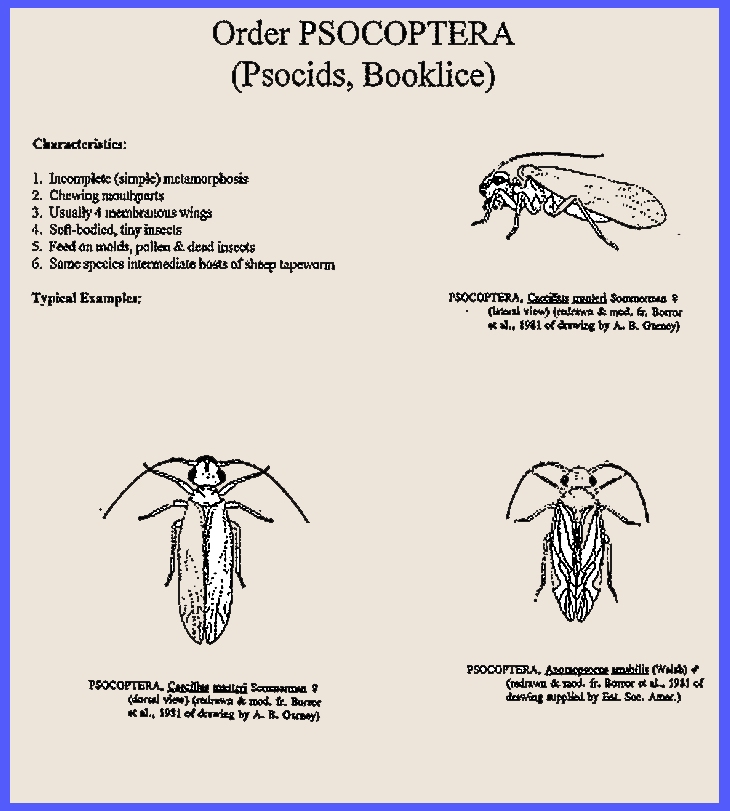File:
<psocoptera.htm> (Entomology), (Invertebrates), (General Index)> <Invertebrate Bibliography> <Glossary> <Site Description>
< Home>
|
Entomology: PSOCOPTERA 1 Kingdom: Animalia, Phylum: Arthropoda Subphylum: Hexapoda: Class: Insecta: Order: Psocoptera (Corrodentia) (Contact)
Please CLICK on underlined
categories to view and on included illustrations to enlarge: Depress Ctrl/F to search for subject matter:
Psocoptera (= Corrodentia), or booklice and
barklice
-- Description>; <Adults> -- are small insects (1/4 to 1/2 centimeter long), that have
both winged and wingless members. Their
close relationship to Isoptera (termites) and other insect groups has been
suggested. Their close relationship
to the Phthiraptera may
eventually have them joined with that order. They have biting mouthparts and
their thoracic segments are distinct.
The wings have a reduced venation and cross-veins are largely
absent. Some adults are wingless.
Their antennae are long and segmented, about one-half the length of the
abdomen. Metamorphosis is incomplete These insects occur on bark and
leaves of trees, and they are frequently found in buildings where warmth and
high humidity are favorable for the growth of molds. They feed on lichens and dry vegetable matter,
fungi, cereals, pollen and fragments of dead insects. Like the Thysanura
(silverfish) they feed on materials that contain starch, such as books,
bindings, wallpaper paste and they contaminate food products. Atropus
pulsatoria, the book louse, inhabits damp, dark rooms and feeds on the
paste of bookbindings, wallpaper, etc.
Some species are gregarious. The eggs are laid singly or in
clusters on plant bark or leaves and covered by a protective sheath of silk by
the female, e.g. Peripsocus phaeopterus. Most species have six
nymphal instars Locomotion is correlated to body
type and ecological needs. Apterous
species are found in books, while winged species are found in outside
environments. Apart from their occasional damage
to starchy products, such as found in books, and gathering numbers in
households, Borror & DeLong (1954) reported that certain species of Liposcelis and Rhyopsocus have
been found to be intermediate hosts of the fringed tapeworm of sheep, Thysanosoma ostinioides Diesing. The storage of books in a warm dry
room and general cleanliness are preventative measures. ------------------------------------------- Details
of Insect Taxonomic Groups Examples of beneficial species
occur in almost every insect order, and considerable information on
morphology and habits has been assembled.
Therefore, the principal groups of insect parasitoids and predators
provide details that refer to the entire class Insecta. These details are available at <taxnames.htm>. ============== |
